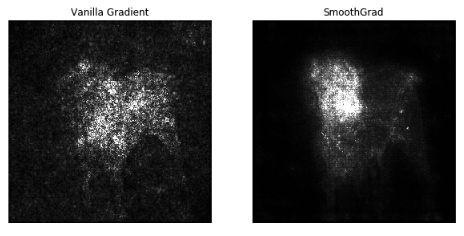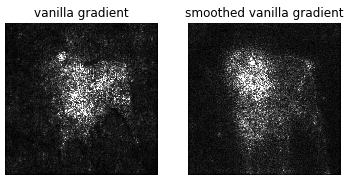Open whyisyoung opened 5 years ago
I noticed that the output gradient is pretty small (1e-14\~1e-7) while much bigger (1e-8\~1e-1) in the https://github.com/PAIR-code/saliency implementation.
First, I tried this notebook: https://github.com/PAIR-code/saliency/blob/master/Examples.ipynb and output the min/max of vanilla gradient and the top 20.
np.max(vanilla_mask_3d), np.min(vanilla_mask_3d)
(0.3862362, -0.38338542)
np.sort(vanilla_mask_3d.ravel())[::-1][:20]
array([0.3862362 , 0.36115727, 0.33639386, 0.3209837 , 0.32015106, 0.31286812, 0.3043984 , 0.3020323 , 0.29084682, 0.28999907, 0.28522477, 0.27706975, 0.27350807, 0.27175996, 0.2703794 , 0.2685724 , 0.26725614, 0.26650152, 0.26406616, 0.26123673], dtype=float32)
But when I run it using deep-viz-keras with the same model and same image, the result looks like this:
np.max(mask), np.min(mask)
(2.2573392039149098e-07, -4.179406574422728e-07)
np.sort(mask.ravel())[::-1][:20]
array([2.25733920e-07, 2.23271692e-07, 1.98080411e-07, 1.92421204e-07, 1.90237181e-07, 1.86172134e-07, 1.81749829e-07, 1.76881710e-07, 1.75296812e-07, 1.75214721e-07, 1.74797302e-07, 1.73955064e-07, 1.71986304e-07, 1.71514253e-07, 1.67088409e-07, 1.66170971e-07, 1.66098115e-07, 1.65983923e-07, 1.65190807e-07, 1.61611446e-07]).
Also, the output mask is not exactly the same.
Here's the PAIR/saliency version:
PAIR/saliency
Here's the deep-vis-keras version:
deep-vis-keras
Here's the notebook code to set deep-viz-keras in the same setting as PAIR/saliency. Notice I used the doberman image from the PAIR/saliency repo (https://github.com/PAIR-code/saliency/blob/master/doberman.png).
slim=tf.contrib.slim if not os.path.exists('models/research/slim'): !git clone https://github.com/tensorflow/models/ old_cwd = os.getcwd() os.chdir('models/research/slim') from nets import inception_v3 os.chdir(old_cwd) if not os.path.exists('inception_v3.ckpt'): #!wget http://download.tensorflow.org/models/inception_v3_2016_08_28.tar.gz !curl -O http://download.tensorflow.org/models/inception_v3_2016_08_28.tar.gz !tar -xvzf inception_v3_2016_08_28.tar.gz ckpt_file = './inception_v3.ckpt' graph = tf.Graph() with graph.as_default(): images = tf.placeholder(tf.float32, shape=(None, 299, 299, 3)) with slim.arg_scope(inception_v3.inception_v3_arg_scope()): _, end_points = inception_v3.inception_v3(images, is_training=False, num_classes=1001) # Restore the checkpoint sess = tf.Session(graph=graph) saver = tf.train.Saver() saver.restore(sess, ckpt_file) # Construct the scalar neuron tensor. logits = graph.get_tensor_by_name('InceptionV3/Logits/SpatialSqueeze:0') neuron_selector = tf.placeholder(tf.int32) y = logits[0][neuron_selector] # Construct tensor for predictions. prediction = tf.argmax(logits, 1) from matplotlib import pylab as P # Boilerplate methods. def ShowImage(im, title='', ax=None): if ax is None: P.figure() P.axis('off') im = ((im + 1) * 127.5).astype(np.uint8) P.imshow(im) P.title(title) def LoadImage(file_path): im = PIL.Image.open(file_path) im = np.asarray(im) return im / 127.5 - 1.0 im = LoadImage('fig/doberman.png') # Show the image ShowImage(im) # Make a prediction. prediction_class = sess.run(prediction, feed_dict = {images: [im]})[0] print("Prediction class: " + str(prediction_class)) # Should be a doberman, class idx = 237 from keras.applications import inception_v3 model = inception_v3.InceptionV3(include_top=True, weights='imagenet') from saliency import GradientSaliency # TODO: how to create an Inception_v3 model here? vanilla = GradientSaliency(model) mask = vanilla.get_mask(im) show_image(mask, ax=plt.subplot('121'), title='vanilla gradient') mask = vanilla.get_smoothed_mask(im) show_image(mask, ax=plt.subplot('122'), title='smoothed vanilla gradient') print(np.max(mask), np.min(mask)) print(np.sort(mask.ravel())[::-1][:20])
Is this a bug? I'll appreciate if anyone can take a look.
I noticed that the output gradient is pretty small (1e-14\~1e-7) while much bigger (1e-8\~1e-1) in the https://github.com/PAIR-code/saliency implementation.
First, I tried this notebook: https://github.com/PAIR-code/saliency/blob/master/Examples.ipynb and output the min/max of vanilla gradient and the top 20.
np.max(vanilla_mask_3d), np.min(vanilla_mask_3d)np.sort(vanilla_mask_3d.ravel())[::-1][:20]But when I run it using deep-viz-keras with the same model and same image, the result looks like this:
np.max(mask), np.min(mask)np.sort(mask.ravel())[::-1][:20]Also, the output mask is not exactly the same.
Here's the
PAIR/saliencyversion:Here's the
deep-vis-kerasversion:Here's the notebook code to set deep-viz-keras in the same setting as PAIR/saliency. Notice I used the doberman image from the PAIR/saliency repo (https://github.com/PAIR-code/saliency/blob/master/doberman.png).
Is this a bug? I'll appreciate if anyone can take a look.